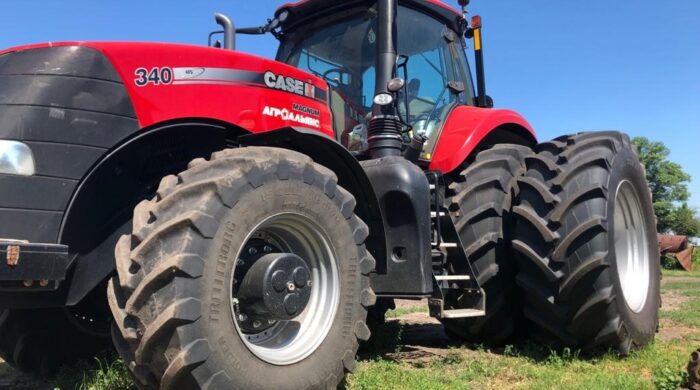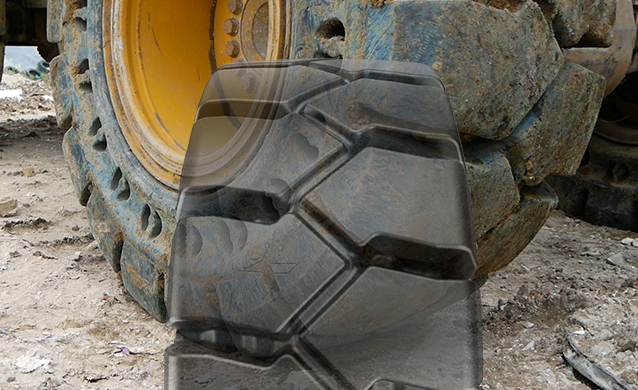MAXAM on Tire Sensors and RFID Tags in AG Tire Use
AG Technical Bulletin – Tire Sensors and RFID Tags in AG Tire Use
Do you foresee Tire Sensors & RFID Tags growing in popularity on AG Tires, what benefits will the farmer/operator receive, and how should Tire Dealers prepare for these next-generation product offerings?
The key to achieving the best value and performance of a tire is to employ the ideal air pressure based on the actual load.
In the agricultural world, there is an indisputable link between the impact of ground pressure and the resulting yield of a planted crop. Tires play a key role in soil compaction and ground pressure as it is the primary tool that creates the ground contact between the machinery and the soil. Due to limited resources, most farmers or growers will set their tire inflation pressures based on the heaviest implement (or axle load) they are required to tow or carry and subsequently never get adjusted for other working conditions. The compressed air within a tire accounts for over 80% of the carrying capacity of the tire, therefore, any technology or tool that improves the impact on ground pressure and overall tire functionality will inevitably result in increased crop yields, delivering a greater value to farmers and growers.
There are three types of evolving technologies that can help the ag industry continue to improve and enhance their tire performance results:
- RFID (Radio Frequency Identification) Technology
- Tire Sensor Technology
- On-Board Tire Inflation Systems
RFID stands for Radio Frequency Identification (RFID). In essence, it is a chip or tag that is embedded inside of a machinery component, or a tire that allows an exchange of data with a portable or fixed reader which employs a radio frequency (RF) signal to passively read the information on the tag or chip. The benefit of this technology in the ag world is the technical information that could be embedded in the selected tire’s RFID tag. This tag would identify the tire brand, size, original tread depth, type, wheel position, and maximum load limits. From a tire performance and tracking point of view, it would instantly identify all the tire information needed to determine the working parameters for active tire management over time.
Tire Sensor Technology moves us another step towards enhancing the performance of tires. A tire sensor is either passive (responds when queried) or active (constantly sending a signal), placed inside the tire preferably on or adjacent to the inner liner. It can also be mounted on the valve stem of the rim or wheel that can actively communicate not only the data provided by an RFID tag but also the actual air pressure and temperature of the tire. As there is a direct link between the machine axle load, the required air pressure to carry the load, and the corresponding temperature caused by the work in progress the data or tire pressure information can trigger a management decision by the operator. The air inflation pressure feedback provides management options that could include speeding up, slowing down, stopping the machinery, or conducting a maintenance routine to adjust the air pressures. The sensor technology gives the ability to use the air pressure data to ensure the optimal inflation for the tire load, thus increasing tire life, reducing the ground pressure, and achieving the benefits of greater crop yields.
The growing use of on-board tire inflation systems moves the above technology to the next level by incorporating both the passive RFID tag technology and the active tire sensor technology feedback into a tire pressure adjustment mechanism that is an integral part of the ag machinery. The onboard systems would include an air pressure system supplied by the machinery that is connected to the tires with the capability to inflate or deflate the tires as needed based on the operators’ working requirements or load needs. The on-board tire inflation systems receive the data from the RFID or sensor tag, located by wheel position on the machinery, and in real-time gives the operator the capability to adjust the tire inflation pressure on the go or as needed without having to stop the machinery. Whether working in the field at slow speeds or transporting the machinery (roading) from field to field at higher speeds, the ability to adjust the tire air pressures as needed can ensure the following benefits:
- Reduced ground compaction as tire load is based on the actual load per axle or per tire as needed.
- Greater crop yields as the compaction impact on the soil is minimized by the improved tire footprint.
- Improved tire wear and reduced sidewall deflection giving the optimum tire gross flat plate or footprint.
- Improved fuel efficiency as the tire is optimized for each work application or towed implement.
- Greater productivity in the field as the tire’s footprint and traction provide increased efficiency.
In summary, each of the above technologies provides a tangible benefit that can deliver improved results to any farmer or grower. MAXAM Tire recommends using all the above technology if the usage parameters are aligned with the selected machinery’s tires specifications, axle loads, load-per tire, and soil conditions. Our recommendation is that the farmer or grower select the above tool that best suits his needs or working conditions in order to achieve his business objectives.
Tire dealers and distributors will have to adapt to the technological solutions selected by each tire manufacturer. Some tire manufacturers will develop in-house tools, and perhaps all the above technologies as part of their brand offer. Some tire manufacturers may adopt off-the-shelf solutions available and offer them as part of an integrated package that supports their product offer. In addition, some of the OEM’s are evaluating On-Board Tire Inflation Systems as part of their optional machinery package enhancements in their equipment offer as they recognize the value and impact of tires on the total cost of ownership of their vehicles. In each case, tire dealers and distributors will need to understand how these tools will integrate with the tire offer and be ready to provide some technical support for proper system implementation or use. Ultimately, the burden will fall on the tire manufacturers to clarify what, why, and how of the tools or technology selected as part of their brand approach in the market to their respective dealers and/or distributors.
MAXAM’s objective for 2022 and beyond is to continue delivering radial products in the right sizes with the right load capabilities engineered to deliver performance and value. Therefore, the technologies listed above when used with our tires will ensure optimal performance that will reduce soil compaction resulting in greater yields while providing improved or increased productivity! Try the MAXAM advantage in your operations today!



